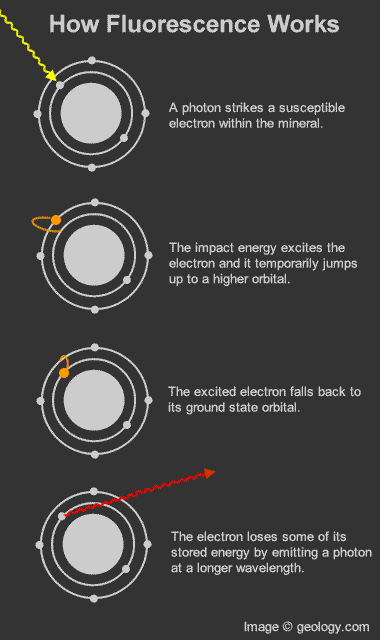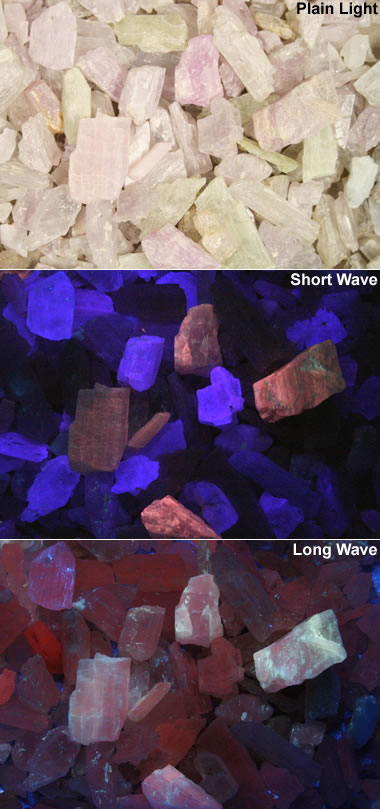Fluorescent Minerals
Learn about the minerals and rocks that "glow" under ultraviolet light

One of the most spectacular museum exhibits is a dark room filled with fluorescent rocks and minerals that are illuminated with ultraviolet light. They glow with an amazing array of vibrant colors - in sharp contrast to the color of the rocks under conditions of normal illumination. The ultraviolet light activates these minerals and causes them to temporarily emit visible light of various colors. This light emission is known as "fluorescence". The wonderful photograph above shows a collection of fluorescent minerals. It was created by Dr. Hannes Grobe and is part of the Wikimedia Commons collection. The photo is used here under a Creative Commons license. |
What is a Fluorescent Mineral?All minerals have the ability to reflect light. That is what makes them visible to the human eye. A few minerals have an interesting physical property known as "fluorescence". These minerals have the ability to temporarily absorb a small amount of light and an instant later release a small amount of light of a different wavelength. This change in wavelength causes a temporary color change of the mineral in the eye of a human observer.The color change of fluorescent minerals is most spectacular when they are illuminated in darkness by ultraviolet light (which is not visible to humans) and they release visible light. The photograph above is an example of this phenomenon. Fluorescence in More DetailFluorescence in minerals occurs when a specimen is illuminated with specific wavelengths of light. Ultraviolet light, x-rays and cathode rays are the typical types of light that trigger fluorescence. These types of light have the ability to excite susceptible electrons within the atomic structure of the mineral. These excited electrons temporarily jump up to a higher orbital within the mineral's atomic structure. When those electrons fall back down to their original orbital a small amount of energy is released in the form of light. This release of light is known as fluorescence. [1]The wavelength of light released from a fluorescent mineral is often distinctly different from the wavelength of the incident light. This produces a visible change in the color of the mineral. This "glow" continues as long as the mineral is illuminated with light of the proper wavelength. 
How Many Minerals Fluoresce in UV Light?Most minerals do not fluoresce. Only about 15% of minerals have this ability and every specimen of those minerals does not fluoresce. [2] Fluorescence usually occurs when specific impurities known as "activators" are present within the mineral. These activators are typically cations of metals such as: tungsten, molybdenum, lead, boron, titanium, manganese, uranium and chromium. Rare earth elements such as europium, terbium, dysprosium, and yttrium are also known to contribute to the fluorescence phenomenon. Fluorescence can also be caused by crystal structural defects or organic impurities.In addition to "activator" impurities, some impurities have a dampening effect on fluorescence. If iron or copper are present as impurities they can reduce or eliminate fluorescence. Furthermore, if the activator mineral is present in large amounts, that can reduce the fluorescence effect. Most minerals fluoresce a single color. Other minerals have multiple colors of fluorescence. Calcite has been known to fluoresce red, blue, white, pink, green and orange. Some minerals are known to exhibit multiple colors of fluorescence in a single specimen. These can be banded minerals that exhibit several stages of growth from parent solutions with changing compositions. Many minerals fluoresce one color under short-wave UV light and another color under long-wave UV light. Fluorite: The Original "Fluorescent Mineral"One of the first people to observe fluorescence in minerals was George Gabriel Stokes in 1852. He noted the ability of fluorite to produce a blue glow when illuminated with invisible light "beyond the violet end of the spectrum". He called this phenomenon "fluorescence" after the mineral fluorite. The name has gained wide acceptance in mineralogy, gemology, biology, optics, commercial lighting and many other fields.Many specimens of fluorite have a strong enough fluorescence that the observer can take them outside, hold them in sunlight then move them into shade and see a color change. Only a few minerals have this level of fluorescence. Fluorite typically glows a blue-violet color under short-wave and long-wave light. Some specimens are known to glow a cream or white color. Many specimens do not fluoresce. Fluorescence in fluorite is thought to be caused by the presence of yttrium, europium, samarium [3] or organic material as activators. Lamps for Viewing Fluorescent MineralsThe lamps used to locate and study fluorescent minerals are very different from the ultraviolet lamps (called "black lights") sold in novelty stores. The novelty store lamps are not suitable for mineral studies for two reasons: 1) they emit long-wave ultraviolet light (most fluorescent minerals respond to short-wave ultraviolet); and, 2) they emit a significant amount of visible light which interferes with accurate observation, but is not a problem for novelty use. [4]The scientific-grade lamps used for mineral studies have a filter that blocks most of the visible light that will interfere with observation. These filters are very expensive and are partly responsible for the significantly higher price of scientific lamps.
UV Lamp SafetyRead the safety instructions provided with your UV lamp prior to use.Ultraviolet light is present in sunlight and is the type of light that causes sunburn. Avoid prolonged exposure of skin to direct UV light. Cover your skin with long sleeve clothing and gloves. Avoid shining the lamp into the eyes of a person or pet. Protect eyes with UV rated safety goggles or glasses. Looking into the lamp can cause serious eye injury. Practical Uses of Fluorescence in MineralsFluorescence has some practical uses in mining, gemology, petrology and mineralogy. The mineral scheelite, an ore of tungsten, typically has a bright blue fluorescence. Geologists prospecting for scheelite sometimes go out at night with fluorescent lamps to look for deposits. They also use fluorescent lamps to examine core specimens and well cuttings. These exploration procedures have also been used for other minerals.Fluorescent lamps can be used in underground mines to identify and trace ore-bearing rocks. They have also been used on picking lines to quickly spot valuable pieces of ore and separate them from waste. Many gemstones are sometimes fluorescent including: ruby, kunzite, diamond and opal. This property can sometimes be used to spot small stones in sediment or crushed ore. It can also be a way to associate stones with a mining locality. For example: light yellow diamonds with strong blue fluorescence are produced by South Africa's Premier mine and colorless stones with a strong blue fluorescence are produced by South Africa's Jagersfontein mine. The stones from these mines are nicknamed "Premiers" and "Jagers". In the early 1900s many diamond merchants would seek out stones with a strong blue fluorescence. They believed that these stones would appear more colorless (less yellow) when viewed in light with a high ultraviolet content. This eventually resulted in controlled lighting conditions for color grading diamonds. [5] Fluorescence is not routinely used in mineral identification. Most minerals are not fluorescent and the property is unpredictable. Calcite provides a good example. Some calcite does not fluoresce. Specimens of calcite that do fluoresce glow in a variety of colors including: red, blue, white, pink, green and orange. It is rarely a diagnostic property. Fluorescent Mineral Books
Other Luminescence PropertiesFluorescence is one of several luminescence properties that a mineral might exhibit. Other luminescence properties include: PHOSPHORESCENCE In fluorescence, electrons excited by incoming photons jump up to a higher energy level and remain there for a tiny fraction of a second before falling back to the ground state and emitting fluorescent light. In phosphorescence the electrons remain in the excited state orbital for a greater amount of time before falling. Minerals with fluorescence stop glowing when the light source is turned off. Minerals with phosphorescence can glow for a brief time after the light source is turned off. Minerals that are sometimes phosphorescent include: calcite, celestine, colemanite, fluorite, sphalerite, and willemite. THERMOLUMINESCENCE Thermoluminescence is the ability of a mineral to emit a small amount of light upon being heated. This heating might be to temperatures as low as 50 to 200 degrees Celsius - much lower than the temperature of incandescence. Apatite, calcite, chlorophane, fluorite, lepidolite, scapolite and some feldspars are occasionally thermoluminescent. TRIBOLUMINESCENCE Some minerals will emit light when mechanical energy is applied to them. These minerals glow when they are struck, crushed, scratched or broken. This light is a result of bonds being broken within the mineral structure. The amount of light emitted is very small and careful observation in the dark is often required. Minerals that sometimes display triboluminescence include: amblygonite, calcite, fluorite, lepidolite, pectolite, quartz, sphalerite, and some feldspars. Contributor: Hobart King http://geology.com/articles/fluorescent-minerals/ | 




|
--
__._,_.___

No comments:
Post a Comment